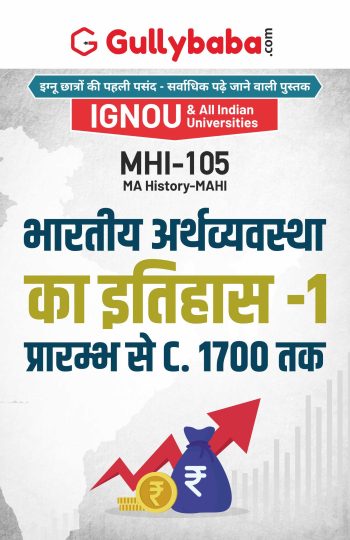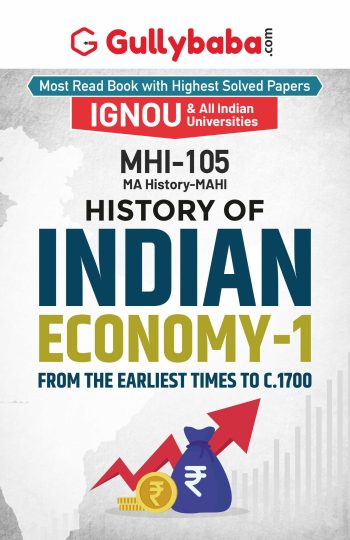#1 Best Selling IGNOU MHI-105 Help-Book & Study-Guide in IGNOU Marketplaces.
Get Good Marks in your MAHI (New) History Programme in the Term-End Exams even if you are busy in your job or profession.
We've sold over 39,534,013 Help Books and Delivered 48,107,677 Assignments Since 2002.
As our customers will tell you...yes, it really result-oriented.
IGNOU MHI-105 Code Details
-
University
IGNOU (Indira Gandhi National Open University)
-
Title
History of Indian Economy-1: From the Earliest Times to c. 1700
-
Language(s)
English and Hindi
-
Code
MHI-105
-
Subject
History
-
Degree(s)
MAHI (New)
-
Course
Core Courses (CC)
IGNOU MHI-105 English Topics Covered
Block 1 - Historiography, Environment and Economy
- Unit 1 - Economic Historiography of Early India
- Unit 2 - Historiography of the Medieval Economy
- Unit 3 - Environmental Zones and Indian Economic History
Block 2 - Emergence of Early Economic Structures
- Unit 1 - Origins of Agriculture, Animal Domestication, Craft Production to Urbanisation (Case of the Harappan Civilisation)
- Unit 2 - Archaeology and Geography of Agricultural and Pastoral Communities of the Subcontinent to the Middle of the First Millennium BCE
Block 3 - Complex Economic Structures
- Unit 1 - Comparative Structures of Economies in Some Early States: Maurya and Kushana
- Unit 2 - Comparative Structures of Economies in Some Early States: Satavahana and Gupta
- Unit 3 - Patterns of Trade, Urbanisation and Linkages: North India (c. 600 BCE-300 CE )
- Unit 4 - Patterns of Trade, Urbanisation and Linkages: Peninsular India (c. 300 BCE-300 CE)
Block 4 - Early Medieval Economy and its Continuities
- Unit 1 - The Indian Feudalism Debate
- Unit 2 - Organisation of Agricultural and Crafts Production: North India, c. 550-1300 CE
- Unit 3 - Regional Profiles of Agrarian Society and Nature of Stratification: North India, c. 550-1300 CE
- Unit 4 - Organisation of Agricultural and Crafts Production, Regional Profiles of Agrarian Society, Nature of Stratification: South India
- Unit 5 - Exchange Networks, Guilds, Merchant Lineages, Items of Trade and Commercial Tax, Urbanisation: North India, c. 300-1300 CE
- Unit 6 - Exchange Networks, Guilds and Merchant Lineages, Items of Trade and Commercial Tax, Urbanisation: South India
Block 5 - Medieval Economy: c. 1300-1700
- Unit 1 - Agricultural Production
- Unit 2 - Agrarian Relations: North India
- Unit 3 - Agrarian Relations: Deccan and South India
- Unit 4 - Non-Agricultural Production and Organisation of Craft Production
- Unit 5 - Fiscal System: North India
- Unit 6 - Fiscal System: Deccan and South India
Block 6 - Trade, Technology, And Urbanisation: c. 1300-1700
- Unit 1 - Inland and Maritime Trade
- Unit 2 - Business Practices and Monetary History
- Unit 3 - Technology and Economy
- Unit 4 - Transport and Communication
- Unit 5 - Urban Centres in Medieval India
Block 7 - Women and Economy
- Unit 1 - Women and Work Upto c. 1300 CE
- Unit 2 - Women and Work: c. 1300-1700 CE
IGNOU MHI-105 Hindi Topics Covered
Block 1 - इतिहासलेखन, पर्यावरण और अर्थव्यवस्था
- Unit 1 - प्रारंभिक भारत की अर्थव्यवस्था का इतिहासलेखन
- Unit 2 - मध्यकालीन अर्थव्यवस्था का इतिहासलेखन
- Unit 3 - पर्यावरण क्षेत्र और भारत का आर्थिक इतिहास
Block 2 - प्रारंभिक आर्थिक संरचनाओं का उद्भव
- Unit 1 - कृषि उद्भव, पशुपालन और शिल्प उत्पादन से नगरीकरण तक (हड़प्पा सभ्यता)
- Unit 2 - उपमहाद्वीपीय कृषक और पशुपालक समुदाय: प्रारंभ से प्रथम सहस्राब्दी बी.सी.ई. के मध्य का पुरातात्विक और भौगोलिक अध्ययन
Block 3 - जटिल अर्थव्यवस्थाएँ
- Unit 1 - कुछ प्रारंभिक राज्यों की अर्थव्यवस्थाओं की तुलनात्मक संरचना: मौर्य एवं कुषाण
- Unit 2 - कुछ प्रारंभिक राज्यों की अर्थव्यवस्थाओं की तुलनात्मक संरचना: सातवाहन एवं गुप्त
- Unit 3 - व्यापार का स्वरूप, शहरीकरण और आपसी संबंध: उत्तर भारत (c. 600 बी.सी.ई. से 300 सी.ई. तक)
- Unit 4 - व्यापार का स्वरूप, शहरीकरण और आपसी संबंध: प्रायद्वीपीय भारत (c. 300 बी.सी.ई. से 300 सी.ई. तक)
Block 4 - प्रारंभिक मध्यकालीन अर्थव्यवस्था और उसकी निरंतरताएँ
- Unit 1 - भारतीय इतिहास में सामंतवाद: विभिन्न दृष्टिकोण
- Unit 2 - कृषि एवं शिल्प उत्पादन का संगठन: उत्तर भारत, c. 550 से 1300 सी.ई.
- Unit 3 - प्रारंभिक मध्यकाल में कृषक समाज की क्षेत्रीय रूपरेखा एवं स्तरीकरण का स्वरूप: बण् 550 से 1300 सी.ई.
- Unit 4 - कृषि एवं शिल्प उत्पादन का संगठन, कृषक समाज की क्षेत्रीय रूपरेखा तथा स्तरीकरण का स्वरूप: दक्षिण भारत, c. 300 से 1300 सी.ई.
- Unit 5 - विनिमय-तंत्र श्रेणियाँ एवं व्यापारी संगठन, व्यापार की वस्तुएँ तथा व्यावसायिक कर, शहरीकरण: उत्तर भारत, c. 300-1300 सी.ई.
- Unit 6 - विनिमय-तंत्र श्रेणियाँ एवं व्यापारी संगठन, व्यापार की वस्तुएँ तथा व्यावसायिक कर, शहरीकरण: दक्षिण भारत
Block 5 - मध्यकालीन अर्थव्यवस्था: c. 1300-1700
- Unit 1 - कृषि उत्पादन
- Unit 2 - कृषि संबंध: उत्तर भारत
- Unit 3 - कृषि संबंध: दक्खन तथा दक्षिण भारत
- Unit 4 - गैर-कृषि उत्पादन तथा शिल्प उत्पादन का संगठन
- Unit 5 - राजस्व प्रणाली : उत्तर भारत
- Unit 6 - राजस्व प्रणाली : दक्खन तथा दक्षिण भारत
Block 6 - व्यापार, तकनीकी तथा शहरीकरण: c. 1300-1700
- Unit 1 - आंतरिक और समुद्री व्यापार
- Unit 2 - व्यावसायिक गतिविधियाँ और मुद्रा व्यवस्था
- Unit 3 - तकनीकी और अर्थव्यवस्था
- Unit 4 - परिवहन और संचार
- Unit 5 - मध्यकालीन भारत में शहरी केंद्र
Block 7 - महिलाएँ तथा अर्थव्यवस्था
- Unit 1 - महिलाएँ तथा श्रम: प्रारंभ से c. 1300 सी.ई. तक
- Unit 2 - महिलाएँ तथा श्रम: c. 1300-1700 सी.ई.
IGNOU MHI-105 (July 2023 - January 2024) Assignment Questions
SECTION A
1. In what ways did the post-1950s ancient Indian economic historical writings represent a departure from early 20th century historical writings?
2. Enumerate the chief characteristic features of the Harappan cities.
3. Discuss the nature of Roman trade in India. What was its long term impact?
4. Assess recent developments in Feudalism Debate.
5. Write short notes on any two of the following. Answer in about 250 words each.
i) Impact of seasons on economy
ii) Ganeshwar-Jodhpura Culture
iii) Merchant Guilds
iv) Pariharas or Immunities
SECTION B
6. Give a historiographical assessment of the Oceanic trade. Evaluate Van Leur’s hypothesis of ‘peddling trade’.
7. Discuss everyday forms of peasant resistance during the medieval period .
8. Critically analyse the pattern of communication network during the medieval period.
9. Examine medieval women’s participation in production activities.
10. Write short notes on any two of the following. Answer in about 250 words each.
i) Pastoral and Forest Economies in the medieval period
ii) Indigo Production
iii) Mughal Artillery
iv) Hundis (Bills of Exchange)
Buy MHI-105 Assignment IGNOU MHI-105 (July 2023 - January 2024) Assignment Questions
भाग-क
1. किस प्रकार उत्तर - 1950 के दशक का प्राचीन भारतीय आर्थिक इतिहास लेखन प्रारम्भिक 20वीं शताब्दी के इतिहास लेखन से भिन्नता दर्शाता है।
2. हड़प्पाई नगरों की प्रमुख विशेषताओं का वर्णन कीजिए।
3. भारत में रोमन व्यापार की प्रकृति की चर्चा कीजिए। इसके दीर्घकालिक प्रभाव क्या थे?
4. सामंतवाद संबंधी विवाद के हाल के शोधों का मूल्यांकन कीजिए।
5. निम्नलिखित में से किन्हीं दो पर लगभग 250 शब्दों में संक्षिप्त टिप्पणियाँ लिखिए:
(i) अर्थव्यवस्था पर मौसमों का प्रभाव
(ii) गणेश्वर-जोधपुरा संस्कृति
(iii) व्यापारिक श्रेणियाँ
(iv) परिहार अथवा प्रतिरक्षाएँ
भाग-ख
6. महासागरीय व्यापार के इतिहास लेखन का मूल्यांकन कीजिए। वान ल्यूर (Van Leur) की फेरीवाला व्यापार की अवधारणा का मूल्यांकन कीजिए।
7. मध्यकाल में दिन-प्रतिदिन के कृषक विरोधों के रूपों की चर्चा कीजिए।
8. मध्यकाल में संचार नेटवर्क के पैटर्न का आलोचनात्मक परीक्षण कीजिए ।
9. मध्यकालीन महिलाओं की उत्पादन प्रक्रिया में भागीदारी का परीक्षण कीजिए ।
10. निम्नलिखित में से किन्हीं दो पर लगभग 250 शब्दों में संक्षिप्त टिप्पणियाँ लिखिए:
(i) मध्यकाल में चारागाही अर्थव्यवस्थाएँ तथा वन
(ii) नील उत्पादन
(iii) मुगल तोपखाना
(iv) हुंडी
Buy MHI-105 Assignment

